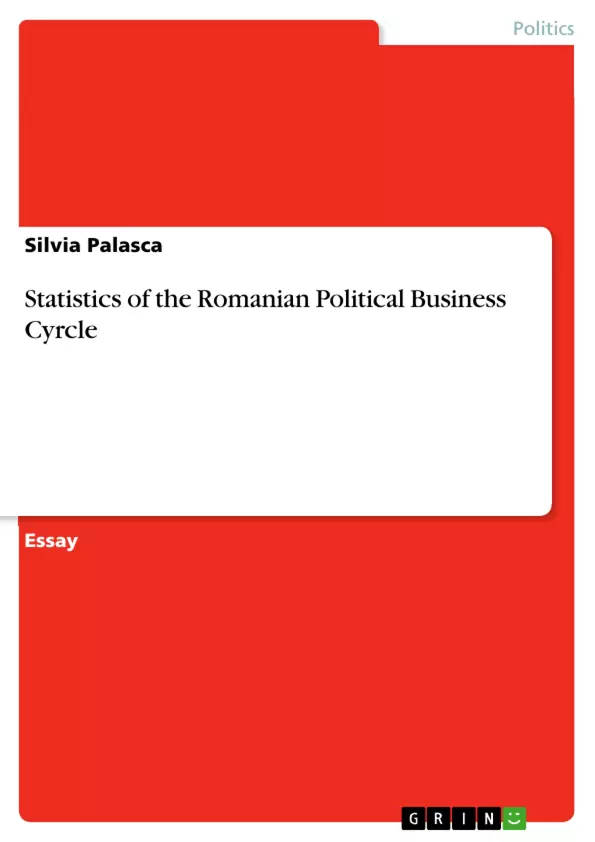The aim of this paper is to prove the occurrence of policy tools manipulation by incumbent politicians prior to an election, followed by the reverse policies after the elections are over, in a cyclical pattern. The paper studies the case of post-communist Romania. Our approach uses foreign currencies exchange rates as indicators of a change in the monetary mass, opposed to the price of gold as an indicator of the real economy. The interest rate for deposits is also analyzed through auto-regressive time series. Statistical analysis of data provides clear evidence of political intrusion in economy in Romania.
Inhaltsverzeichnis (Table of Contents)
- 1. INTRODUCTION
- 2. LITERATURE REVIEW
- 2.1. The “adaptive expectations electorate”
- 2.2. Rationality of voters
- 2.3. Rational partisan models
- 2.4. New approach for developing countries
- 2.5. The Romanian case
- 3. EMPIRICAL RESULTS FOR ROMANIA
- 3.1. Gold- the expression of the real economy
- 3.2. The U.S. Dollar and the Euro as political tools
- 3.3. The interest rate for deposits-Austrian theory put to empiric test
- 4. Conclusions and future work
Zielsetzung und Themenschwerpunkte (Objectives and Key Themes)
This paper aims to demonstrate the manipulation of policy tools by incumbent politicians prior to an election, followed by the reversal of these policies after the elections. The study focuses on post-communist Romania, using foreign currency exchange rates as indicators of changes in the monetary mass and the price of gold as a measure of the real economy. The paper investigates the cyclical pattern of these economic indicators in relation to elections, analyzing the deposit interest rate through autoregressive time series. The key themes explored in the paper include:- The existence of a political business cycle in post-communist Romania
- The manipulation of economic indicators by politicians for electoral gain
- The use of foreign currency exchange rates and gold prices as measures of economic manipulation
- The role of the deposit interest rate in influencing monetary policy and election cycles
- The implications of political business cycles for economic stability and development
Zusammenfassung der Kapitel (Chapter Summaries)
1. INTRODUCTION
This chapter introduces the concept of the political business cycle (PBC) and argues that it is particularly prevalent in developing countries. The paper outlines the objectives of the study, which is to provide empirical evidence of the PBC in post-communist Romania. The chapter also describes the methodology, which focuses on analyzing foreign currency exchange rates, the price of gold, and the deposit interest rate.2. LITERATURE REVIEW
This chapter reviews existing literature on the political business cycle. It discusses early models that emphasized the opportunistic behavior of politicians and the naive electorate. The chapter then explores subsequent models that incorporate rational behavior of voters and partisan politics. Finally, it examines recent studies that use new economic indicators to analyze the political business cycle in developing countries, including Romania.3. EMPIRICAL RESULTS FOR ROMANIA
This chapter presents the empirical findings of the study. It analyzes the price of gold, the exchange rates of the U.S. Dollar and the Euro, and the deposit interest rate in Romania between 1995 and 2012. Using ARIMA models, the study finds evidence of political manipulation of these economic indicators, particularly in the months leading up to elections.3.1. Gold- the expression of the real economy
This section analyzes the price of gold as an indicator of the real economy. The study finds that the price of gold in Romania is not significantly influenced by pre-election periods, suggesting that it is a more reliable indicator of the country’s economic health than other, more volatile variables.3.2. The U.S. Dollar and the Euro as political tools
This section investigates the exchange rates of the U.S. Dollar and the Euro as indicators of the political business cycle. The study finds that the exchange rates of both currencies are significantly influenced by pre-election periods, particularly in the case of the U.S. Dollar.3.3. The interest rate for deposits-Austrian theory put to empiric test
This section examines the deposit interest rate as a key factor in influencing monetary policy and the political business cycle. The study finds that the interest rate for deposits in Romania exhibits a cyclical pattern, with a significant increase in the months leading up to elections, followed by a sharp decline after the elections.Schlüsselwörter (Keywords)
The main keywords and focus topics of the text include ARIMA models, deposit interest rate, foreign currency, political business cycle, and post-communist Romania. The paper examines the influence of political factors on economic indicators, particularly the exchange rate of foreign currencies and the deposit interest rate. The study utilizes empirical data from Romania to analyze the cyclical patterns of these indicators in relation to elections.
Excerpt out of 7 pages
- scroll top
- Quote paper
- Silvia Palasca (Author), 2013, Statistics of the Romanian Political Business Cyrcle, Munich, GRIN Verlag, https://www.grin.com/document/215748
Look inside the ebook



